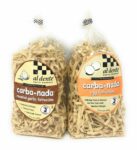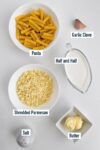Skinny pasta is a type of pasta made with different ingredients than traditional wheat semolina pasta in order to reduce calories and carbohydrates. Skinny pasta brands often use fiber, protein or alternative grains and flours like buckwheat, quinoa and amaranth in place of wheat to achieve lower calorie counts ranging from 60 calories per serving up to around 150 calories. Some varieties incorporate vegetables like zucchini and carrots, yielding as few as 30 calories per serving. Compared to around 200 calories for an equivalent-sized portion of wheat pasta, these alternatives enable significant calorie savings while still providing pasta dishes. In addition to lower calories, skinny pasta can offer benefits like more fiber, a feeling of fullness from fiber and protein, and a lower glycemic impact.
However, labels should be checked carefully to ensure options contain mainly whole food ingredients rather than fillers for the healthiest skinny pasta choices.
What Is Skinny Pasta?
Skinny pasta refers to types of pasta made from ingredients other than traditional durum wheat semolina flour in order to significantly reduce the calorie and carbohydrate content. By replacing wheat with alternative ingredients that are inherently lower in calories, skinny pasta brands aim to offer consumers pasta dishes that are healthier and less impactful on blood sugar.
Depending on the specific ingredients used – from fibers and proteins to vegetable additions – the calorie counts of skinny pasta varieties can range from as few as around 60 calories per 85 gram serving all the way up to approximately 150 calories for portions of the same size. This contrasts with the roughly 200 calories contained in an equivalent-sized portion of standard wheat pasta.
The non-wheat ingredients in skinny pasta also tend to provide benefits like more fiber, a feeling of fullness due to fiber and protein, and a lower glycemic impact compared to regular pasta made from durum wheat semolina flour.
Ingredients In Skinny Pasta
Skinny pasta brands utilize a variety of alternative ingredients in place of traditional durum wheat semolina flour in order to significantly reduce the calorie and carbohydrate content of their products.
Fiber is the primary ingredient used in many skinny pasta varieties, with various types listed as the first ingredient on labels. Insoluble fibers like cellulose and wheat dextrin provide structure and bulk with minimal calories, allowing manufacturers to achieve portion sizes similar to wheat pasta while keeping calorie counts lower.
Protein is added to some skinny pasta varieties, primarily from plant-based sources like pea, lentil and chickpea. The extra protein provides more substance and satiety to the pasta dishes while also contributing some calories in the range of 120 to 150 per 85 gram serving.
Alternative grains like buckwheat, quinoa, amaranth and brown rice flour are used in some skinny pasta options. While these grains contain carbohydrates, their calorie counts per weight are lower than wheat, thereby enabling slightly lower calorie pasta. The use of whole grains can also increase fiber.
Vegetables, mainly in the form of spiralized zucchini, carrots, sweet potatoes and butternut squash, represent another type of ingredient used in some skinny pasta varieties. The vegetable noodles are essentially calorie-free due to being comprised completely of water and fiber, yielding as few as 30 calories per 85 gram portion.
Overall, the specific blend of ingredients used – whether primarily fiber with small amounts of protein or alternative grains, or heavily featuring vegetable noodles – determines the final calorie count and uniqueness of a given skinny pasta option. But they all rely on ingredients inherently lower in calories per weight than wheat semolina flour in order to reduce the calorie density of the pasta itself to enable truly “skinny” pasta dishes.
Calorie Count of Skinny Pasta
The calorie content of skinny pasta varieties differs significantly compared to traditional wheat pasta due largely to their alternative ingredients.
A standard 85 gram portion of durum wheat semolina pasta contains roughly 200 calories on average. This calorie count serves as a benchmark for how significantly lower in calories many skinny pasta options are.
Fiber-based skinny pasta made primarily with insoluble fibers as a structure agent tends to range from 60 calories per 85 gram serving up to around 100 calories depending on the addition of other ingredients. These pastas rely mainly on fiber to achieve a portion size similar in shape and weight to wheat pasta despite containing far fewer calories.
Protein-based skinny pasta made with ingredients like pea flour and lentils to contribute both substance and calories generally provides from 120 calories per 85 grams up to around 150 calories per portion. The extra protein requires more calories but also offers benefits like satiety and protein content.
Vegetable-based skinny pasta made from spiralized zucchini noodles, sweet potato spaghetti or butternut squash linguine typically contains the fewest calories at between 30 calories per serving up to approximately 60 calories. This extremely low calorie range stems from the pasta essentially consisting of water and fiber from the vegetables with negligible carbohydrate content.
In comparison to the roughly 200 calories contained in an equivalent portion of standard wheat pasta, these calorie ranges for different types of skinny pasta – from as low as 30 calories per serving up to no more than around 150 calories – represent reductions of at least 50% and as much as 85% fewer calories.
This significant decrease in calorie density is what enables skinny pasta dishes that are truly “skinny” in comparison to the same-sized portions pasta made from durum wheat semolina flour, though the fiber, protein and vegetable additions can also offer benefits beyond just calories.
Other Types Of Low Calorie Pasta
In addition to skinny pasta made with fiber, protein or alternative grains and vegetables, there are other options that provide truly low calorie counts through different ingredients and formulations.
Shirataki noodles are a type of konjac-based pasta that contains virtually no calories due to being made from the konjac yam plant. The raw shirataki noodles themselves consist almost entirely of water and fiber, providing fewer than 20 calories per 85 gram serving. Their extremely low calorie content makes shirataki a suitable choice for those looking for the absolute lowest calorie pasta option.
Egg pasta made with egg yolks in addition to durum wheat semolina flour offers a slightly higher calorie pasta that is still lower in calories than standard wheat varieties. While still containing some wheat, egg pasta derives calories primarily from the protein-rich egg ingredients, yielding a range of around 140 calories per serving up to approximately 170 calories, depending on the proportion of eggs used. The benefits include higher protein content alongside some modest calorie reduction.
Lentil and bean pasta made with legume flours in place of a portion of the durum wheat provides another alternative that is slightly higher in calories but offers nutritional benefits. Pasta made primarily from lentils or chickpeas generally contains around 120 calories per serving. While higher in calories than shirataki or vegetable noodles, legume pasta packs fiber, protein and other nutrients alongside a modest calorie decrease of roughly 20% compared to standard wheat pasta.
Vegetable pasta in the form of zoodles or noodles made from spiralized zucchini, spaghetti squash linguine or carrot ribbons provides the absolute lowest calorie options beyond skinny pasta formulations. These vegetable noodles naturally contain negligible carbohydrates due to consisting of mostly water and fiber, yielding as few as 10 calories per serving up to a maximum of around 50 calories depending on the vegetable and portion size. Vegetable pasta allows for creating truly calorie-free pasta dishes.
Of all these alternatives, shirataki noodles provide the fewest calories per serving at under 20 while vegetable pastas in the form of zoodles and spaghetti squash offer the most significant calorie reductions of at least 75% compared to standard wheat pasta. However, the options higher in calories like egg, lentil and bean pasta can still offer nutritional benefits while providing a decrease in calorie density to qualify as a type of “low calorie pasta.”
Benefits Of Skinny Pasta
In addition to significantly lower calorie counts compared to traditional wheat pasta, skinny pasta formulations can provide several nutritional benefits:
- Higher fiber – Skinny pasta made primarily with insoluble fibers as a main ingredient contains substantially more fiber than wheat pasta. The extra fiber aids with digestion and feeling full.
- More filling – The addition of fiber and protein in some skinny pasta varieties makes them more filling and satisfying despite their lower calorie content. This is due to how proteins and fibers take longer to digest.
- Lower glycemic impact – By containing fewer rapidly digestible carbohydrates than wheat pasta through relying more on fiber, protein and vegetables, skinny pasta tends to have a lower effect on blood sugar after eating. This makes them a healthier option for those managing blood sugar levels.
- Healthier ingredients – When carefully checking labels to ensure selections contain mainly whole food ingredients like fibers, vegetables and legumes rather than fillers, skinny pasta brands can provide a healthier choice compared to wheat pasta made simply with durum semolina flour.
These nutritional benefits – stemming from higher fiber, the addition of protein, and the use of whole food ingredients with minimal carbohydrates – offer advantages beyond just the significantly lower calorie counts of skinny pasta varieties compared to standard wheat pasta.
Skinny pasta relies on ingredients inherently lower in calories per weight than wheat semolina flour, such as fibers, proteins, alternative grains, and vegetables, in order to significantly reduce calories compared to traditional pasta. In addition to lower calorie counts, skinny pasta can provide benefits like more fiber, protein and a lower glycemic impact.
FAQs
1. What is skinny pasta made of?
Skinny pasta contains alternative ingredients like fiber, protein, alternative grains, and vegetables in place of durum wheat semolina flour.
2. How many calories are in skinny pasta?
Skinny pasta contains 60 to 150 calories per serving, compared to around 200 calories for an equal amount of wheat pasta.
3. Is skinny pasta healthy?
It depends on the ingredients and formulation. Check labels for whole food ingredients and higher fiber/protein to determine the healthiest options.
4. What’s the lowest calorie pasta?
Vegetable pastas made from spiralized zucchini, squash or carrot contain as few as 10 to 50 calories per serving, compared to over 200 calories for wheat pasta.




